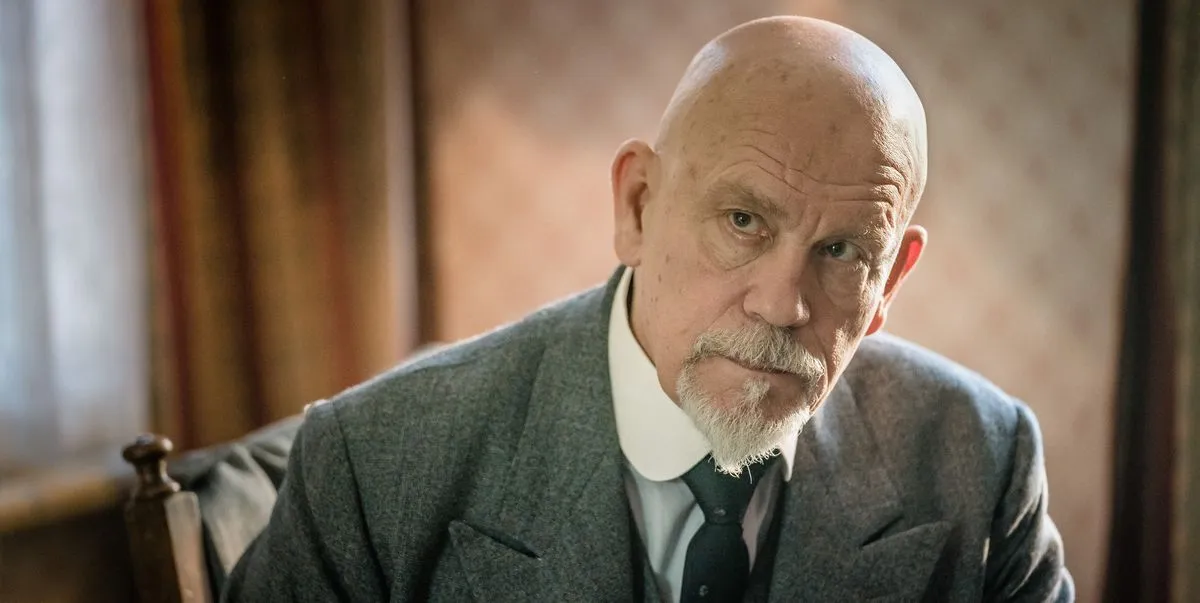
John Malkovich is the latest famous actor to don the celebrated mustaches of Hercule Poirot in The ABC Murders.
#television #movies #crime #horror #writing #bbc #agathachristie
The ABC Murders (2018), directed by Alex Gabassi of The Frankenstein Chronicles series; from three scripts by Sarah Phelps; starring John Malkovich, Eamon Farren, Michael Schaeffer, and Rupert Grint.
This three-part miniseries is an Agatha Christie-based production from the BBC, which Amazon is now streaming as its own branded original.
It stars John Malkovich as Belgie detective extraordinaire, Hercule Poirot, who is tasked with solving one of Christie’s most bizarre cases: a serial killer who is offing his victims in alphabetical order. The first victim is Alice Asher from Andover, the second is Betty Barnard from Brexhill. You get the idea. . .
This could have been a fun and whip-smart series, but alas, it’s terrible on an epic scale. I don’t have the vocabulary to adequately describe the full-on craptacular quality of this benighted production. But I will try.
Much as I respect Malky as an actor, he is ridiculously miscast in this series. An American of Croatian ancestry, he looks far too Slavic to play a Belgie. His accent sucks, and he keeps drifting in and out of it. He is also too tall, at six foot, to play the famously shrimpy shamus. In addition, he’s saddled with a modified Fu Manchu beard, which, combined with his somewhat Asiatic features, makes him look like an opium-addicted Mandarin satrap. (The Poirot of the books had his famous mustaches, but no beard.)
The script by Phelps (who wrote the more successful, 2015 BBC production of And Then There Were None) only makes Malkovich’s ridiculousness even more ridiculous. Phelps has completely dumped the Poirot that Christie created, and invented a radically different back story. He is no longer the wounded World War I ex-soldier who came to England to recuperate and a retired Belgian police captain who loves fine food, fancy clothes, and modern art. No, not anymore.
Now, he’s a formerly pathetic and penniless WWI refugee, who fled to England to escape evil Germans and blantantly lied to British officials about being a policeman. The refugee angle is played up hard, clearly pushing an obvious contemporary political agenda, which anyone who follows current events in Europe would know. The agenda is so transparent and ham-fisted, it’s insulting.
Instead of the quirky, narcissistic bon vivant that Christie’s readers loved, Poirot is now an austere Catholic fundamentalist who maintains a shrine to the Virgin Mary in his apartment. WTF? And he’s in acute emotional pain about some mysterious event that occurred during the war, instead of being the affable, twinkle-eyed Poirot of the books. I mean, really, WTF?
In fact, this whole series is a thuddingly copious bonanza of WTF moments.
Item: in one especially bizarre scene, the main suspect (Farren) hires a prostitute to walk on his nude back in vicious-looking high heels, until his skin is pocked with bloody sores. WTF?
Item: The suspect sees a fellow boarder at his rooming house with a large, disgusting, yellow boil on his neck. Then he’s served a sunnyside-up egg for breakfast, relates it to the boil, and then runs to a sink to puke his guts out. All of which is filmed in loving, deliberate, and lurid camerawork. Again, WTF?
Item: The camera focuses on a woman in a tatty, working class-hovel smoking a cigarette and turning magazine pages in v-e-r-y s-l-o-w motion, then she scratches her ankle. WTF?
Note: There are numerous scenes like the last item throughout the film: s-l-o-w, artsy shots of mundane and often disgusting human interactions that serve no purpose to the story. It’s as if the director learned in film school that slow, artsy camerawork is the undisputed hallmark of a “good” film and so has decided to pack as much of it into his production as possible. These shots are weird and tedious beyond belief.
Item: To top it all off, toward the end of the last episode, we learn this weird new Poirot's dark secret from the war, and it's the biggest WTF of them all. I mean, seriously, it's a cast-iron, Mrs.-Christie-spinning-in-her-grave, doozy of a WTF.
Casting Call for Repulsive-Looking Actors
Now for the other characters: Gone is the working-class, dogged Inspector Japp; he’s dead of a heart attack in the first few moments of the film. He’s been replaced by an Inspector Crome, a ginger-haired, snarling autocrat who despises Poirot, played by Rupert Grint, aka Ron Weasley from the Harry Potter movies. (Yeah, the casting is horrible all around.) Gone, too, is Captain Hastings, Poirot’s unofficial partner in the novel, who provides much-needed comic relief with his dim-witted comments and actions. There is no place for Hastings’s special brand of brilliant dullardry in this series; it would cut into the precious time allotted for long close-ups of repulsive skin conditions, oozing bloody sores, and loud, graphic vomiting sessions.
In addition to being often disgusting, this series is horribly classist. Working-class Brits—but, curiously, only the white ones—are portrayed as physically repulsive, brutish, slutty (the women), sweaty, encrusted with grime, dishonest, and generally just a hair’s breadth above subhuman. Forget about the shrewd, likable, salt-of-the-earth Cockneys that Christie actually wrote about; they're not good enough for Miss Sarah Phelps.
Aristocrats and middle-class professionals fare little better in the portrayal of their foibles and flaws, but at least they are clean and pretty to look at.
The majority of Christie fans will most assuredly hate this production, but afficionados of The Human Centipede might be willing to give it a go.
4/10 and that’s being generous. Very generous